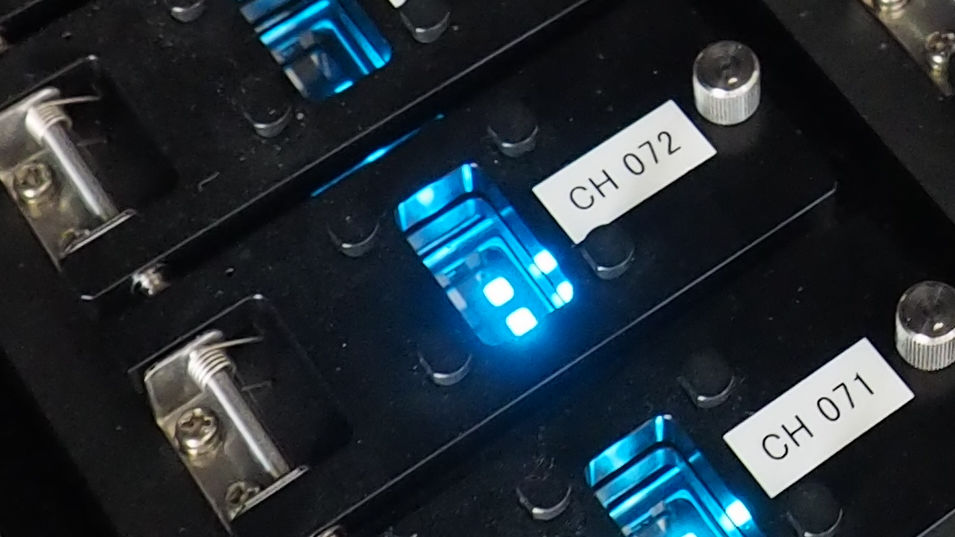Researchers at Kyushu University have introduced a blue light source that could lead to more efficient OLED displays, while, at the same time, emitting blue light without compromise to the quality or purity of the light. The light source is based on a combination of emitter molecules that split energy conversion and emission processes, allowing the scientists to achieve devices that produce pure blue emission with high efficiency and maintain their brightness.
Additionally, the approach does not require the use of expensive metal atoms.
OLEDs provide certain advantages over other technologies, in that they can be deployed in thin and flexible displays and can produce deeper blacks, due to the fact that individual pixels can be turned off, which also increases power efficiency. However, in the pursuit of efficient OLED displays with pure colors, blue has proven to be something of a trouble spot.

Highly efficient, pure-blue organic light-emitting diodes (OLEDs) developed by researchers at Kyushu University in Japan are being tested to measure their lifetime. Courtesy of Masaki Tanaka, Kyushu University.
“A growing number of options exist for red and green OLEDs with excellent performance, but devices emitting high-energy blue light are more of a challenge, with trade-offs almost always occurring among efficiency, color purity, cost, and lifetime,” said Chin-Yiu Chan, a researcher at Kysuhu University’s OPERA (Center for Organic Photonics and Electronics Research) and an author of the study.
Currently, stable blue emitters based on fluorescence are used in commercially available displays, though they suffer from a low maximum efficiency. So-called phosphorescent emitters can achieve an ideal quantum efficiency of 100%, though they tend to exhibit shorter operational lifetimes and require expensive materials such as iridium and platinum.
To find an alternative, researchers at OPERA have been working with molecules that emit light through TADF (thermally activated delayed fluorescence). The molecules achieve excellent efficiency without the need for expensive metals, though they are apt to emit a broader range of colors than desired.
“The range of colors a display can produce is directly related to the purity of the red, green, and blue pixels,” said Chihaya Adachi, director of OPERA. “If blue emission is not pure within a narrow spectrum, filters are needed to improve the color purity, but this wastes emitted energy.”

Seeking to overcome issues of purity, Takuji Hatakeyama’s group at Kwansei Gakuin University developed a promising design for a highly efficient pure-blue TADF emitter. The molecule in the design, however, called v-DABNA, quickly degrades under operation.
In collaboration with Hatakeyama, OPERA researchers found that lifetime can be greatly improved while still obtaining narrow emission by combining the v-DABNA molecule with an additional TADF molecules developed at OPERA as an intermediate high-speed energy converter.
“Three-fourths of electrical charges combine to form energy states called triplets in OLEDS, and TADF molecules can convert these nonemitting triplets into light-emitting singlets,” said Masaki Tanaka, an OPERA researcher who worked closely with Chan on the study. “However, v-DABNA is somewhat slow at converting the high-energy triplets, which often play a role in degradation. To get rid of the dangerous triplets more quickly, we included an intermediary TADF molecule that can more rapidly convert triplets into singlets.”
Although the intermediary molecule can quickly convert triplets, it boasts a wide emission spectrum, producing a sky-blue emission. It can transfer many of its singlets in a high-energy state to v-DABNA for fast and pure blue emission, however.
“Compared to most emitters, the wavelengths that v-DABNA can absorb are very close to the color it emits. This unique property makes it able to receive much of the energy from the wide-emission intermediary and still emit a pure blue,” Chan said.
This method, termed hyperfluorescence, allowed the researchers to achieve longer operational lifetimes at high brightness than previously reported for highly efficient OLEDs with similar color purity.
By applying this tandem structure design that essentially stacks two devices to double emission for the same electrical current, the researchers demonstrated the ability to nearly double lifetime (at high brightness).
The researchers ultimately estimated that devices could maintain 50% of their brightness for over 10,000 hours at more moderate intensities.
“Though this is still too short for practical applications, stricter control of fabrication conditions often leads to even longer lifetimes, so these initial results point to a very promising future for this approach to finally obtain an efficient and stable pure-blue OLED,” Adachi said.
The research was published in Nature Photonics (www.doi.org/10.1038/s41566-020-00745-z).